Health Services for ATSI and Anglo-Australian Communities: Analysis
VerifiedAdded on 2023/06/03
|11
|2905
|165
Essay
AI Summary
This essay examines the significant health disparities between Aboriginal and Torres Strait Islander (ATSI) communities and the Anglo-Australian population. It highlights the widening gap in life expectancy and prevalence of diseases like cardiovascular infections, mental disorders, diabetes, and chronic respiratory infections within the ATSI communities. The essay delves into historical factors, particularly the impact of colonialism, land dispossession, racism, and discrimination, which have profoundly affected the health and well-being of the ATSI people. It discusses how these historical injustices have created barriers to healthcare access and influenced social determinants of health. The essay emphasizes the need for culturally sensitive and holistic solutions, including new policies and strategies to address the health inequalities. It also explores the roles of primary healthcare, government initiatives like the Closing the Gap program, and the importance of equitable, efficient, and effective healthcare frameworks. The analysis underscores the critical importance of addressing social determinants such as employment, education, and housing to achieve health equality. The essay references various studies and reports from organizations like the ABS, WHO, AIHW, and Australian Institute of Criminology to support its arguments.
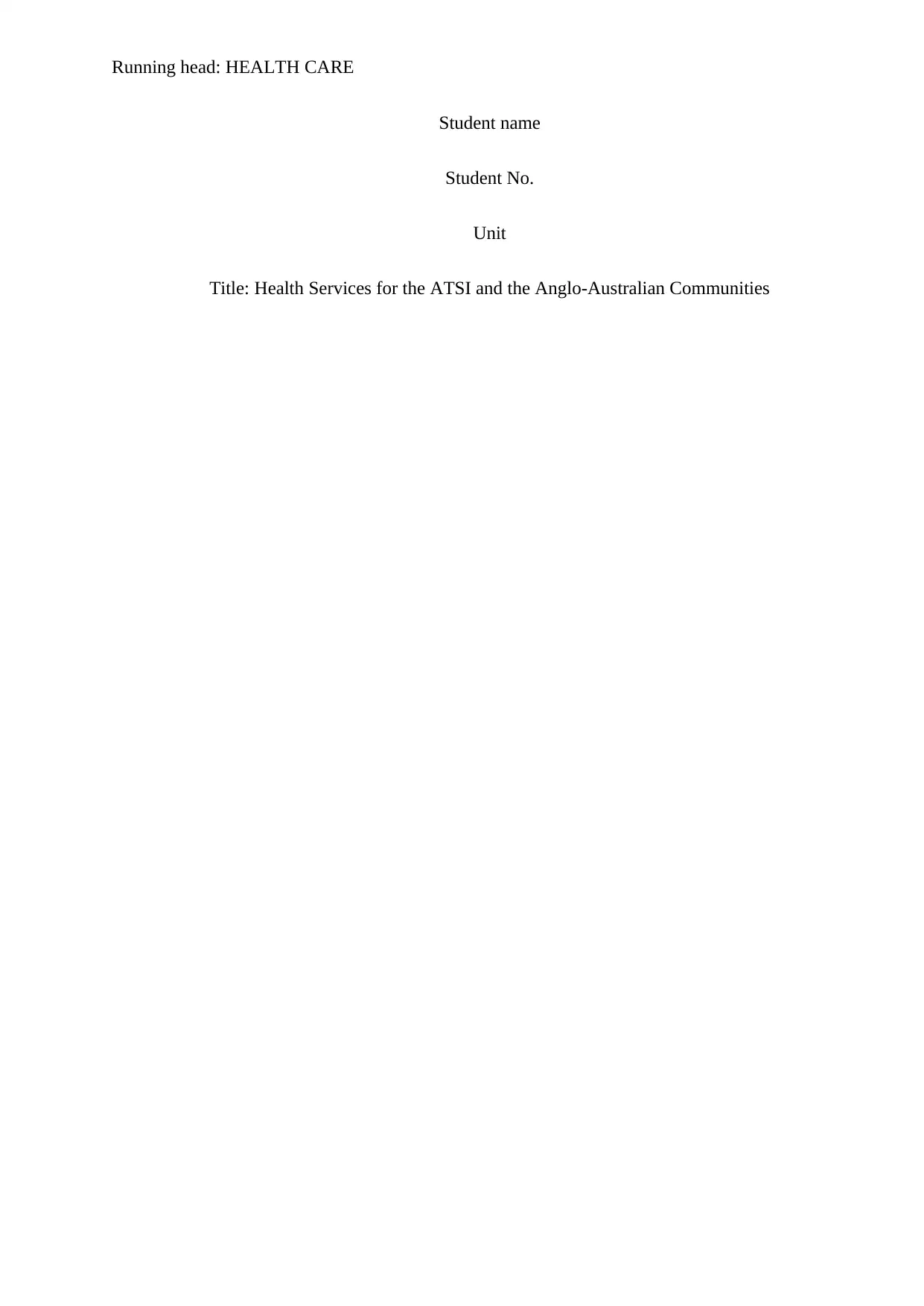
Running head: HEALTH CARE
Student name
Student No.
Unit
Title: Health Services for the ATSI and the Anglo-Australian Communities
Student name
Student No.
Unit
Title: Health Services for the ATSI and the Anglo-Australian Communities
Paraphrase This Document
Need a fresh take? Get an instant paraphrase of this document with our AI Paraphraser
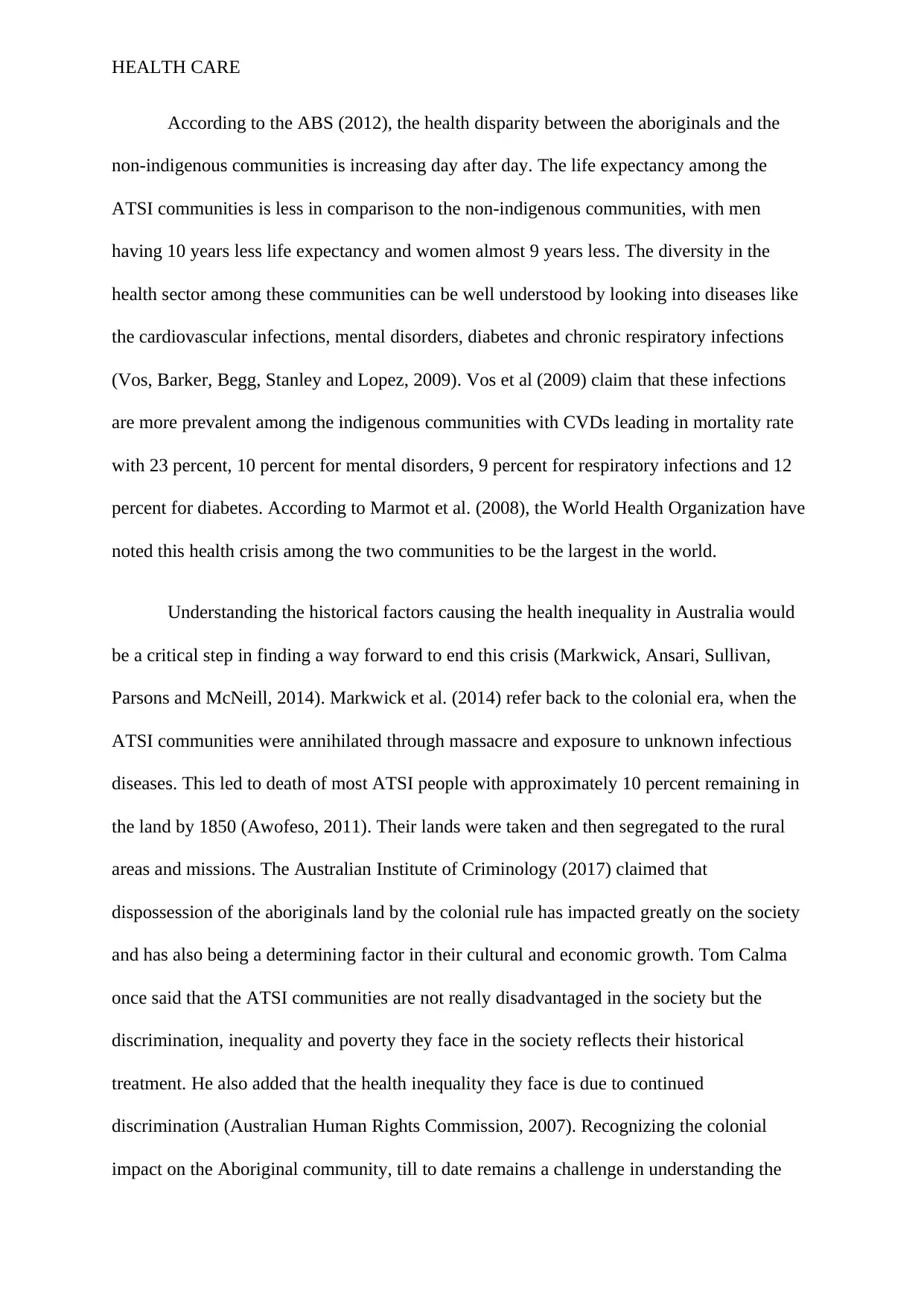
HEALTH CARE
According to the ABS (2012), the health disparity between the aboriginals and the
non-indigenous communities is increasing day after day. The life expectancy among the
ATSI communities is less in comparison to the non-indigenous communities, with men
having 10 years less life expectancy and women almost 9 years less. The diversity in the
health sector among these communities can be well understood by looking into diseases like
the cardiovascular infections, mental disorders, diabetes and chronic respiratory infections
(Vos, Barker, Begg, Stanley and Lopez, 2009). Vos et al (2009) claim that these infections
are more prevalent among the indigenous communities with CVDs leading in mortality rate
with 23 percent, 10 percent for mental disorders, 9 percent for respiratory infections and 12
percent for diabetes. According to Marmot et al. (2008), the World Health Organization have
noted this health crisis among the two communities to be the largest in the world.
Understanding the historical factors causing the health inequality in Australia would
be a critical step in finding a way forward to end this crisis (Markwick, Ansari, Sullivan,
Parsons and McNeill, 2014). Markwick et al. (2014) refer back to the colonial era, when the
ATSI communities were annihilated through massacre and exposure to unknown infectious
diseases. This led to death of most ATSI people with approximately 10 percent remaining in
the land by 1850 (Awofeso, 2011). Their lands were taken and then segregated to the rural
areas and missions. The Australian Institute of Criminology (2017) claimed that
dispossession of the aboriginals land by the colonial rule has impacted greatly on the society
and has also being a determining factor in their cultural and economic growth. Tom Calma
once said that the ATSI communities are not really disadvantaged in the society but the
discrimination, inequality and poverty they face in the society reflects their historical
treatment. He also added that the health inequality they face is due to continued
discrimination (Australian Human Rights Commission, 2007). Recognizing the colonial
impact on the Aboriginal community, till to date remains a challenge in understanding the
According to the ABS (2012), the health disparity between the aboriginals and the
non-indigenous communities is increasing day after day. The life expectancy among the
ATSI communities is less in comparison to the non-indigenous communities, with men
having 10 years less life expectancy and women almost 9 years less. The diversity in the
health sector among these communities can be well understood by looking into diseases like
the cardiovascular infections, mental disorders, diabetes and chronic respiratory infections
(Vos, Barker, Begg, Stanley and Lopez, 2009). Vos et al (2009) claim that these infections
are more prevalent among the indigenous communities with CVDs leading in mortality rate
with 23 percent, 10 percent for mental disorders, 9 percent for respiratory infections and 12
percent for diabetes. According to Marmot et al. (2008), the World Health Organization have
noted this health crisis among the two communities to be the largest in the world.
Understanding the historical factors causing the health inequality in Australia would
be a critical step in finding a way forward to end this crisis (Markwick, Ansari, Sullivan,
Parsons and McNeill, 2014). Markwick et al. (2014) refer back to the colonial era, when the
ATSI communities were annihilated through massacre and exposure to unknown infectious
diseases. This led to death of most ATSI people with approximately 10 percent remaining in
the land by 1850 (Awofeso, 2011). Their lands were taken and then segregated to the rural
areas and missions. The Australian Institute of Criminology (2017) claimed that
dispossession of the aboriginals land by the colonial rule has impacted greatly on the society
and has also being a determining factor in their cultural and economic growth. Tom Calma
once said that the ATSI communities are not really disadvantaged in the society but the
discrimination, inequality and poverty they face in the society reflects their historical
treatment. He also added that the health inequality they face is due to continued
discrimination (Australian Human Rights Commission, 2007). Recognizing the colonial
impact on the Aboriginal community, till to date remains a challenge in understanding the
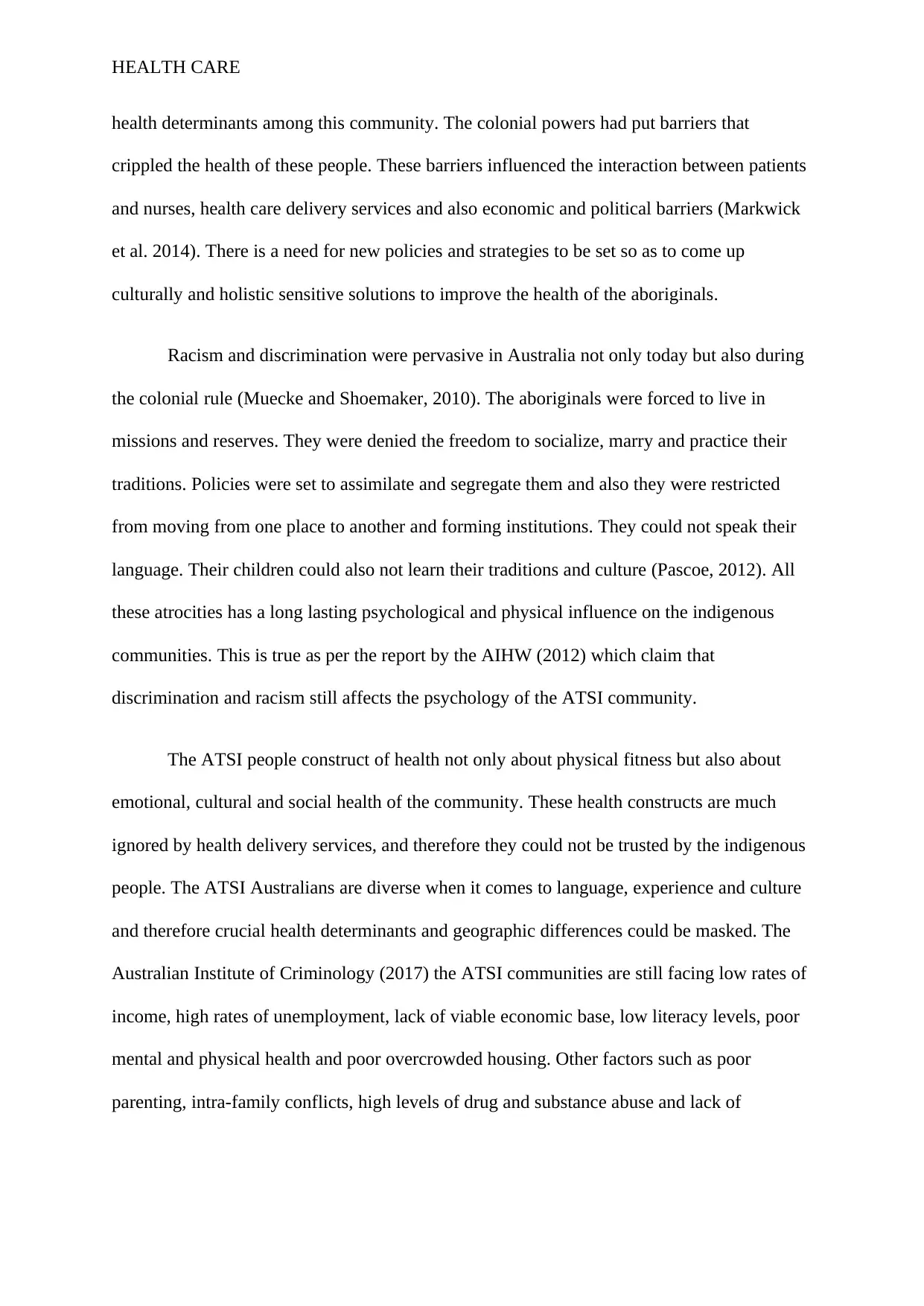
HEALTH CARE
health determinants among this community. The colonial powers had put barriers that
crippled the health of these people. These barriers influenced the interaction between patients
and nurses, health care delivery services and also economic and political barriers (Markwick
et al. 2014). There is a need for new policies and strategies to be set so as to come up
culturally and holistic sensitive solutions to improve the health of the aboriginals.
Racism and discrimination were pervasive in Australia not only today but also during
the colonial rule (Muecke and Shoemaker, 2010). The aboriginals were forced to live in
missions and reserves. They were denied the freedom to socialize, marry and practice their
traditions. Policies were set to assimilate and segregate them and also they were restricted
from moving from one place to another and forming institutions. They could not speak their
language. Their children could also not learn their traditions and culture (Pascoe, 2012). All
these atrocities has a long lasting psychological and physical influence on the indigenous
communities. This is true as per the report by the AIHW (2012) which claim that
discrimination and racism still affects the psychology of the ATSI community.
The ATSI people construct of health not only about physical fitness but also about
emotional, cultural and social health of the community. These health constructs are much
ignored by health delivery services, and therefore they could not be trusted by the indigenous
people. The ATSI Australians are diverse when it comes to language, experience and culture
and therefore crucial health determinants and geographic differences could be masked. The
Australian Institute of Criminology (2017) the ATSI communities are still facing low rates of
income, high rates of unemployment, lack of viable economic base, low literacy levels, poor
mental and physical health and poor overcrowded housing. Other factors such as poor
parenting, intra-family conflicts, high levels of drug and substance abuse and lack of
health determinants among this community. The colonial powers had put barriers that
crippled the health of these people. These barriers influenced the interaction between patients
and nurses, health care delivery services and also economic and political barriers (Markwick
et al. 2014). There is a need for new policies and strategies to be set so as to come up
culturally and holistic sensitive solutions to improve the health of the aboriginals.
Racism and discrimination were pervasive in Australia not only today but also during
the colonial rule (Muecke and Shoemaker, 2010). The aboriginals were forced to live in
missions and reserves. They were denied the freedom to socialize, marry and practice their
traditions. Policies were set to assimilate and segregate them and also they were restricted
from moving from one place to another and forming institutions. They could not speak their
language. Their children could also not learn their traditions and culture (Pascoe, 2012). All
these atrocities has a long lasting psychological and physical influence on the indigenous
communities. This is true as per the report by the AIHW (2012) which claim that
discrimination and racism still affects the psychology of the ATSI community.
The ATSI people construct of health not only about physical fitness but also about
emotional, cultural and social health of the community. These health constructs are much
ignored by health delivery services, and therefore they could not be trusted by the indigenous
people. The ATSI Australians are diverse when it comes to language, experience and culture
and therefore crucial health determinants and geographic differences could be masked. The
Australian Institute of Criminology (2017) the ATSI communities are still facing low rates of
income, high rates of unemployment, lack of viable economic base, low literacy levels, poor
mental and physical health and poor overcrowded housing. Other factors such as poor
parenting, intra-family conflicts, high levels of drug and substance abuse and lack of
⊘ This is a preview!⊘
Do you want full access?
Subscribe today to unlock all pages.

Trusted by 1+ million students worldwide
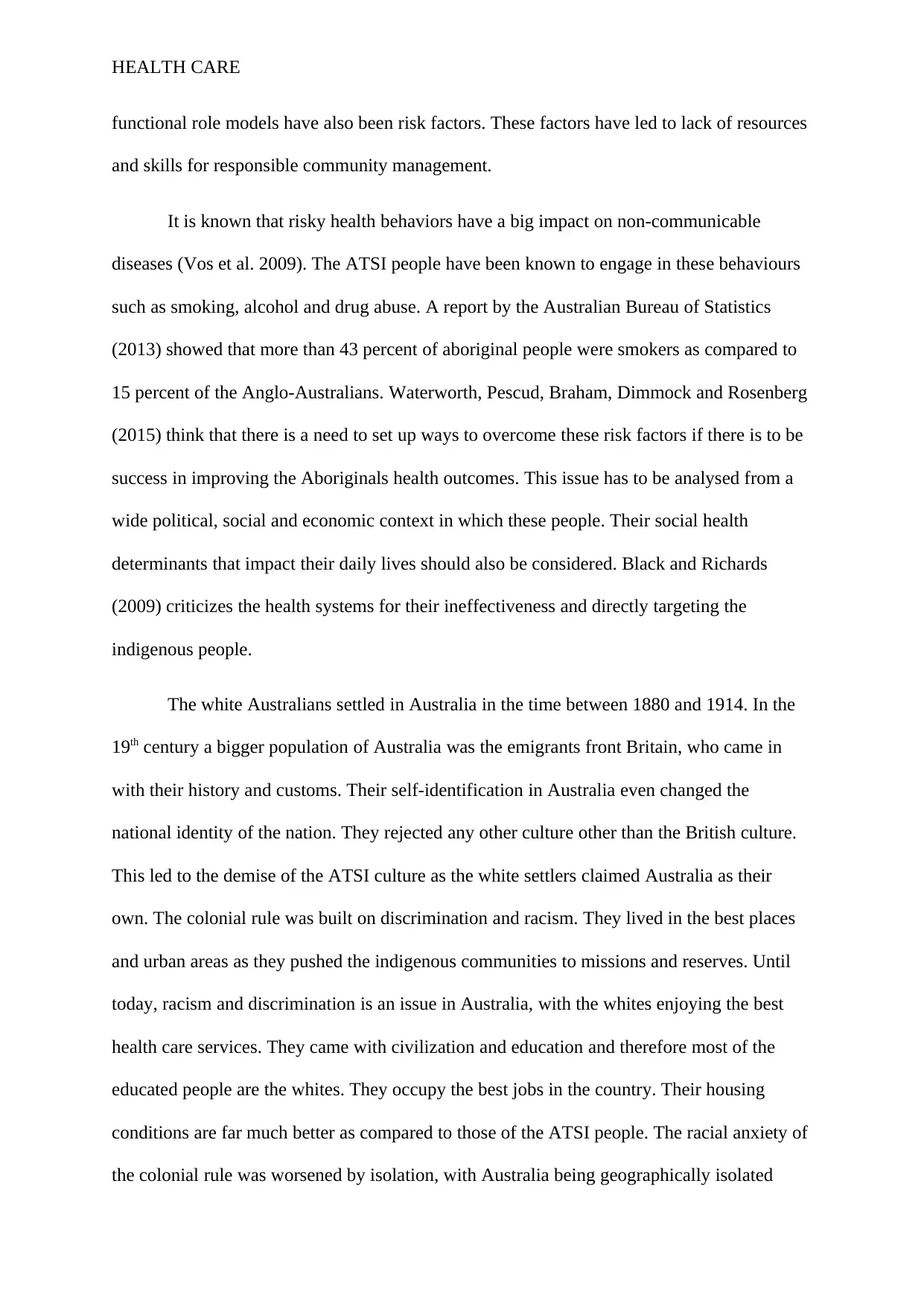
HEALTH CARE
functional role models have also been risk factors. These factors have led to lack of resources
and skills for responsible community management.
It is known that risky health behaviors have a big impact on non-communicable
diseases (Vos et al. 2009). The ATSI people have been known to engage in these behaviours
such as smoking, alcohol and drug abuse. A report by the Australian Bureau of Statistics
(2013) showed that more than 43 percent of aboriginal people were smokers as compared to
15 percent of the Anglo-Australians. Waterworth, Pescud, Braham, Dimmock and Rosenberg
(2015) think that there is a need to set up ways to overcome these risk factors if there is to be
success in improving the Aboriginals health outcomes. This issue has to be analysed from a
wide political, social and economic context in which these people. Their social health
determinants that impact their daily lives should also be considered. Black and Richards
(2009) criticizes the health systems for their ineffectiveness and directly targeting the
indigenous people.
The white Australians settled in Australia in the time between 1880 and 1914. In the
19th century a bigger population of Australia was the emigrants front Britain, who came in
with their history and customs. Their self-identification in Australia even changed the
national identity of the nation. They rejected any other culture other than the British culture.
This led to the demise of the ATSI culture as the white settlers claimed Australia as their
own. The colonial rule was built on discrimination and racism. They lived in the best places
and urban areas as they pushed the indigenous communities to missions and reserves. Until
today, racism and discrimination is an issue in Australia, with the whites enjoying the best
health care services. They came with civilization and education and therefore most of the
educated people are the whites. They occupy the best jobs in the country. Their housing
conditions are far much better as compared to those of the ATSI people. The racial anxiety of
the colonial rule was worsened by isolation, with Australia being geographically isolated
functional role models have also been risk factors. These factors have led to lack of resources
and skills for responsible community management.
It is known that risky health behaviors have a big impact on non-communicable
diseases (Vos et al. 2009). The ATSI people have been known to engage in these behaviours
such as smoking, alcohol and drug abuse. A report by the Australian Bureau of Statistics
(2013) showed that more than 43 percent of aboriginal people were smokers as compared to
15 percent of the Anglo-Australians. Waterworth, Pescud, Braham, Dimmock and Rosenberg
(2015) think that there is a need to set up ways to overcome these risk factors if there is to be
success in improving the Aboriginals health outcomes. This issue has to be analysed from a
wide political, social and economic context in which these people. Their social health
determinants that impact their daily lives should also be considered. Black and Richards
(2009) criticizes the health systems for their ineffectiveness and directly targeting the
indigenous people.
The white Australians settled in Australia in the time between 1880 and 1914. In the
19th century a bigger population of Australia was the emigrants front Britain, who came in
with their history and customs. Their self-identification in Australia even changed the
national identity of the nation. They rejected any other culture other than the British culture.
This led to the demise of the ATSI culture as the white settlers claimed Australia as their
own. The colonial rule was built on discrimination and racism. They lived in the best places
and urban areas as they pushed the indigenous communities to missions and reserves. Until
today, racism and discrimination is an issue in Australia, with the whites enjoying the best
health care services. They came with civilization and education and therefore most of the
educated people are the whites. They occupy the best jobs in the country. Their housing
conditions are far much better as compared to those of the ATSI people. The racial anxiety of
the colonial rule was worsened by isolation, with Australia being geographically isolated
Paraphrase This Document
Need a fresh take? Get an instant paraphrase of this document with our AI Paraphraser
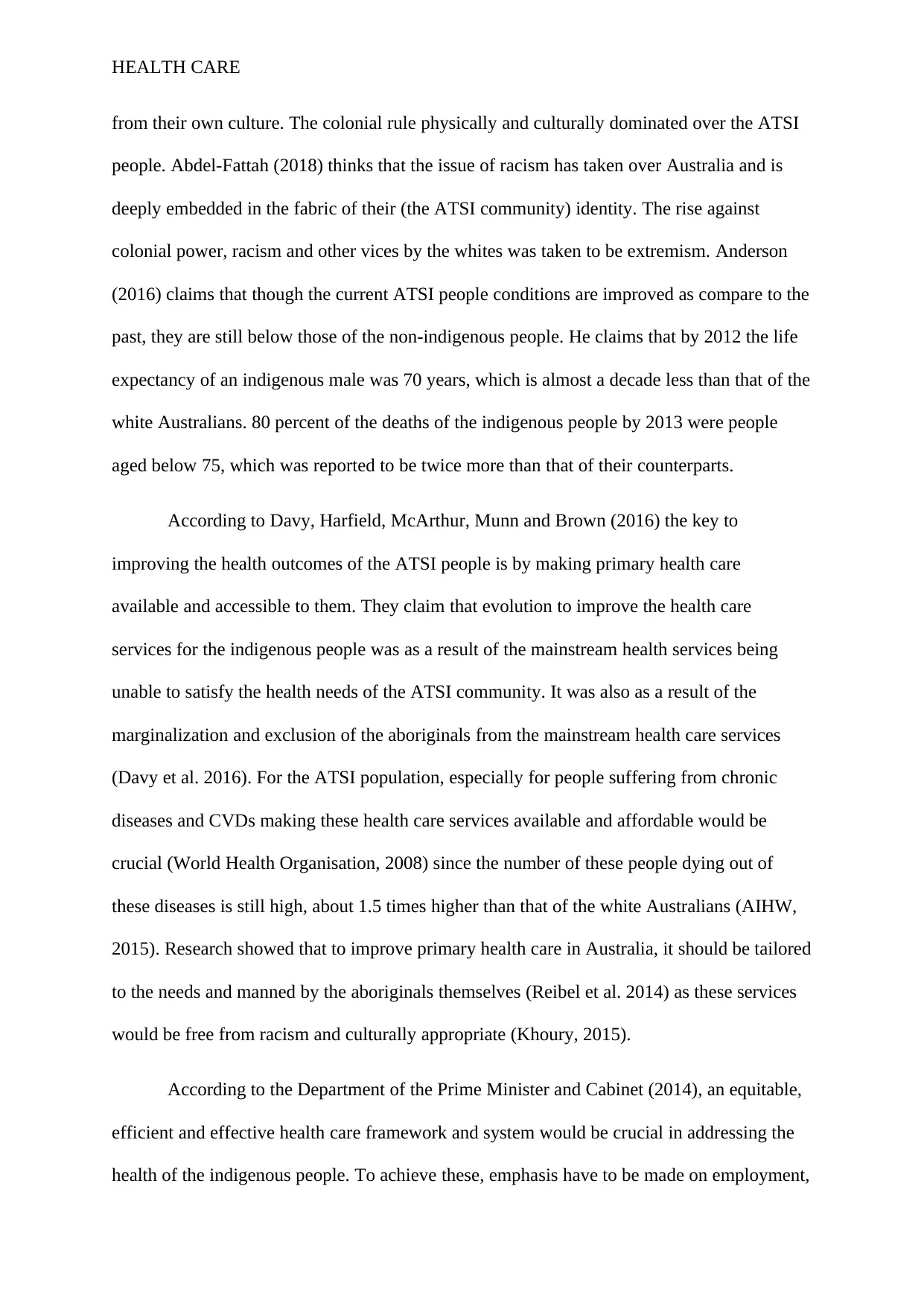
HEALTH CARE
from their own culture. The colonial rule physically and culturally dominated over the ATSI
people. Abdel-Fattah (2018) thinks that the issue of racism has taken over Australia and is
deeply embedded in the fabric of their (the ATSI community) identity. The rise against
colonial power, racism and other vices by the whites was taken to be extremism. Anderson
(2016) claims that though the current ATSI people conditions are improved as compare to the
past, they are still below those of the non-indigenous people. He claims that by 2012 the life
expectancy of an indigenous male was 70 years, which is almost a decade less than that of the
white Australians. 80 percent of the deaths of the indigenous people by 2013 were people
aged below 75, which was reported to be twice more than that of their counterparts.
According to Davy, Harfield, McArthur, Munn and Brown (2016) the key to
improving the health outcomes of the ATSI people is by making primary health care
available and accessible to them. They claim that evolution to improve the health care
services for the indigenous people was as a result of the mainstream health services being
unable to satisfy the health needs of the ATSI community. It was also as a result of the
marginalization and exclusion of the aboriginals from the mainstream health care services
(Davy et al. 2016). For the ATSI population, especially for people suffering from chronic
diseases and CVDs making these health care services available and affordable would be
crucial (World Health Organisation, 2008) since the number of these people dying out of
these diseases is still high, about 1.5 times higher than that of the white Australians (AIHW,
2015). Research showed that to improve primary health care in Australia, it should be tailored
to the needs and manned by the aboriginals themselves (Reibel et al. 2014) as these services
would be free from racism and culturally appropriate (Khoury, 2015).
According to the Department of the Prime Minister and Cabinet (2014), an equitable,
efficient and effective health care framework and system would be crucial in addressing the
health of the indigenous people. To achieve these, emphasis have to be made on employment,
from their own culture. The colonial rule physically and culturally dominated over the ATSI
people. Abdel-Fattah (2018) thinks that the issue of racism has taken over Australia and is
deeply embedded in the fabric of their (the ATSI community) identity. The rise against
colonial power, racism and other vices by the whites was taken to be extremism. Anderson
(2016) claims that though the current ATSI people conditions are improved as compare to the
past, they are still below those of the non-indigenous people. He claims that by 2012 the life
expectancy of an indigenous male was 70 years, which is almost a decade less than that of the
white Australians. 80 percent of the deaths of the indigenous people by 2013 were people
aged below 75, which was reported to be twice more than that of their counterparts.
According to Davy, Harfield, McArthur, Munn and Brown (2016) the key to
improving the health outcomes of the ATSI people is by making primary health care
available and accessible to them. They claim that evolution to improve the health care
services for the indigenous people was as a result of the mainstream health services being
unable to satisfy the health needs of the ATSI community. It was also as a result of the
marginalization and exclusion of the aboriginals from the mainstream health care services
(Davy et al. 2016). For the ATSI population, especially for people suffering from chronic
diseases and CVDs making these health care services available and affordable would be
crucial (World Health Organisation, 2008) since the number of these people dying out of
these diseases is still high, about 1.5 times higher than that of the white Australians (AIHW,
2015). Research showed that to improve primary health care in Australia, it should be tailored
to the needs and manned by the aboriginals themselves (Reibel et al. 2014) as these services
would be free from racism and culturally appropriate (Khoury, 2015).
According to the Department of the Prime Minister and Cabinet (2014), an equitable,
efficient and effective health care framework and system would be crucial in addressing the
health of the indigenous people. To achieve these, emphasis have to be made on employment,
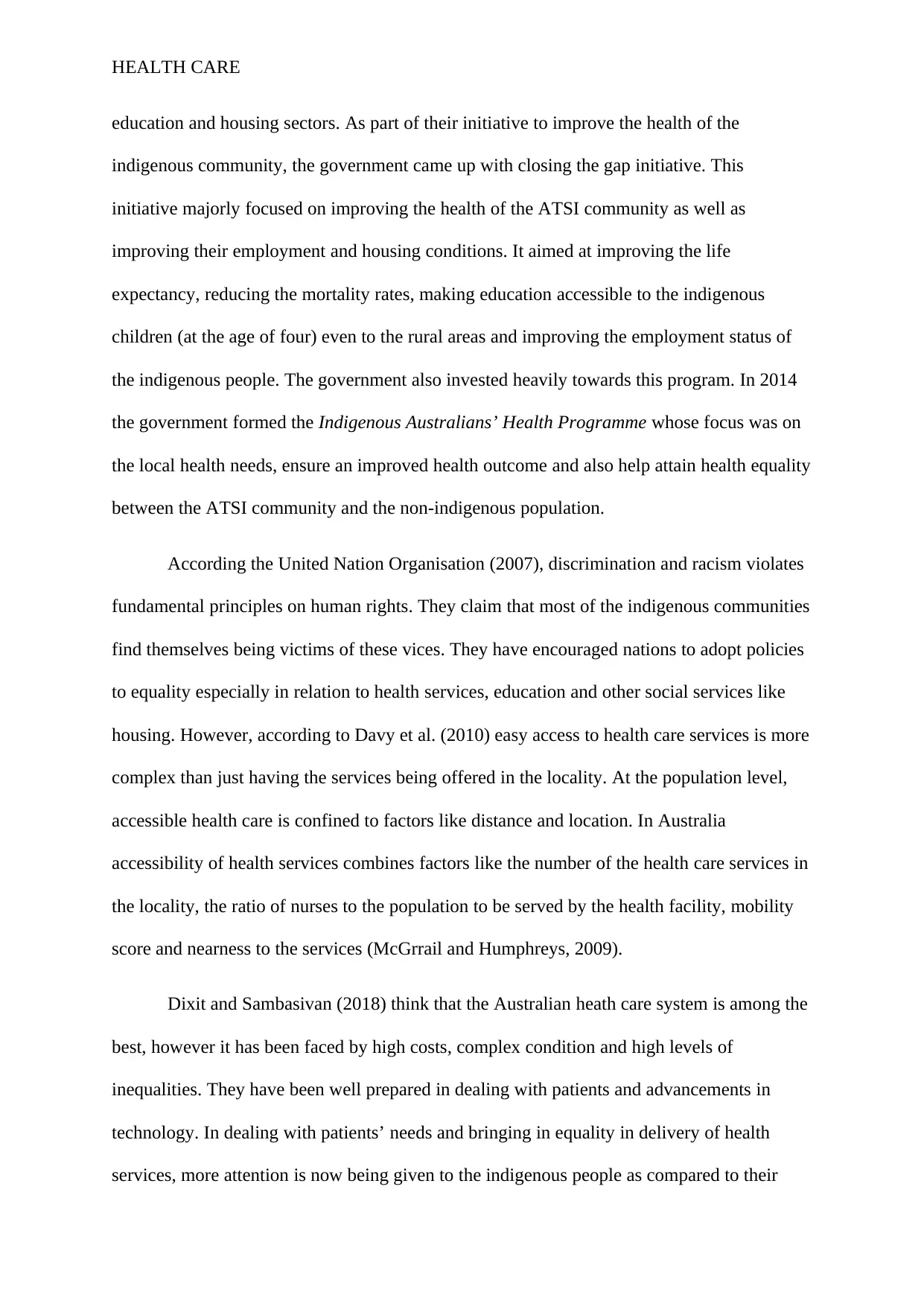
HEALTH CARE
education and housing sectors. As part of their initiative to improve the health of the
indigenous community, the government came up with closing the gap initiative. This
initiative majorly focused on improving the health of the ATSI community as well as
improving their employment and housing conditions. It aimed at improving the life
expectancy, reducing the mortality rates, making education accessible to the indigenous
children (at the age of four) even to the rural areas and improving the employment status of
the indigenous people. The government also invested heavily towards this program. In 2014
the government formed the Indigenous Australians’ Health Programme whose focus was on
the local health needs, ensure an improved health outcome and also help attain health equality
between the ATSI community and the non-indigenous population.
According the United Nation Organisation (2007), discrimination and racism violates
fundamental principles on human rights. They claim that most of the indigenous communities
find themselves being victims of these vices. They have encouraged nations to adopt policies
to equality especially in relation to health services, education and other social services like
housing. However, according to Davy et al. (2010) easy access to health care services is more
complex than just having the services being offered in the locality. At the population level,
accessible health care is confined to factors like distance and location. In Australia
accessibility of health services combines factors like the number of the health care services in
the locality, the ratio of nurses to the population to be served by the health facility, mobility
score and nearness to the services (McGrrail and Humphreys, 2009).
Dixit and Sambasivan (2018) think that the Australian heath care system is among the
best, however it has been faced by high costs, complex condition and high levels of
inequalities. They have been well prepared in dealing with patients and advancements in
technology. In dealing with patients’ needs and bringing in equality in delivery of health
services, more attention is now being given to the indigenous people as compared to their
education and housing sectors. As part of their initiative to improve the health of the
indigenous community, the government came up with closing the gap initiative. This
initiative majorly focused on improving the health of the ATSI community as well as
improving their employment and housing conditions. It aimed at improving the life
expectancy, reducing the mortality rates, making education accessible to the indigenous
children (at the age of four) even to the rural areas and improving the employment status of
the indigenous people. The government also invested heavily towards this program. In 2014
the government formed the Indigenous Australians’ Health Programme whose focus was on
the local health needs, ensure an improved health outcome and also help attain health equality
between the ATSI community and the non-indigenous population.
According the United Nation Organisation (2007), discrimination and racism violates
fundamental principles on human rights. They claim that most of the indigenous communities
find themselves being victims of these vices. They have encouraged nations to adopt policies
to equality especially in relation to health services, education and other social services like
housing. However, according to Davy et al. (2010) easy access to health care services is more
complex than just having the services being offered in the locality. At the population level,
accessible health care is confined to factors like distance and location. In Australia
accessibility of health services combines factors like the number of the health care services in
the locality, the ratio of nurses to the population to be served by the health facility, mobility
score and nearness to the services (McGrrail and Humphreys, 2009).
Dixit and Sambasivan (2018) think that the Australian heath care system is among the
best, however it has been faced by high costs, complex condition and high levels of
inequalities. They have been well prepared in dealing with patients and advancements in
technology. In dealing with patients’ needs and bringing in equality in delivery of health
services, more attention is now being given to the indigenous people as compared to their
⊘ This is a preview!⊘
Do you want full access?
Subscribe today to unlock all pages.

Trusted by 1+ million students worldwide
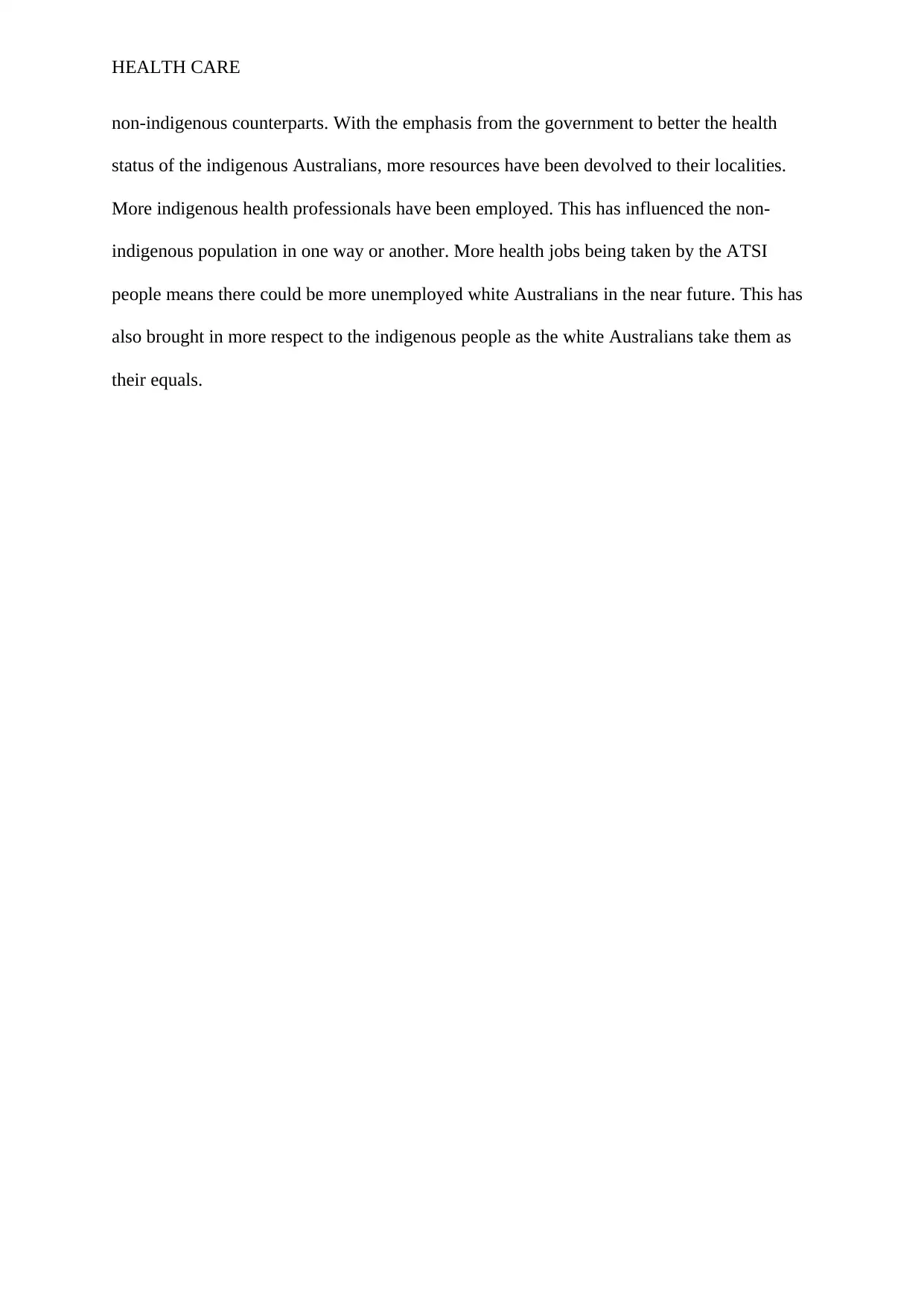
HEALTH CARE
non-indigenous counterparts. With the emphasis from the government to better the health
status of the indigenous Australians, more resources have been devolved to their localities.
More indigenous health professionals have been employed. This has influenced the non-
indigenous population in one way or another. More health jobs being taken by the ATSI
people means there could be more unemployed white Australians in the near future. This has
also brought in more respect to the indigenous people as the white Australians take them as
their equals.
non-indigenous counterparts. With the emphasis from the government to better the health
status of the indigenous Australians, more resources have been devolved to their localities.
More indigenous health professionals have been employed. This has influenced the non-
indigenous population in one way or another. More health jobs being taken by the ATSI
people means there could be more unemployed white Australians in the near future. This has
also brought in more respect to the indigenous people as the white Australians take them as
their equals.
Paraphrase This Document
Need a fresh take? Get an instant paraphrase of this document with our AI Paraphraser
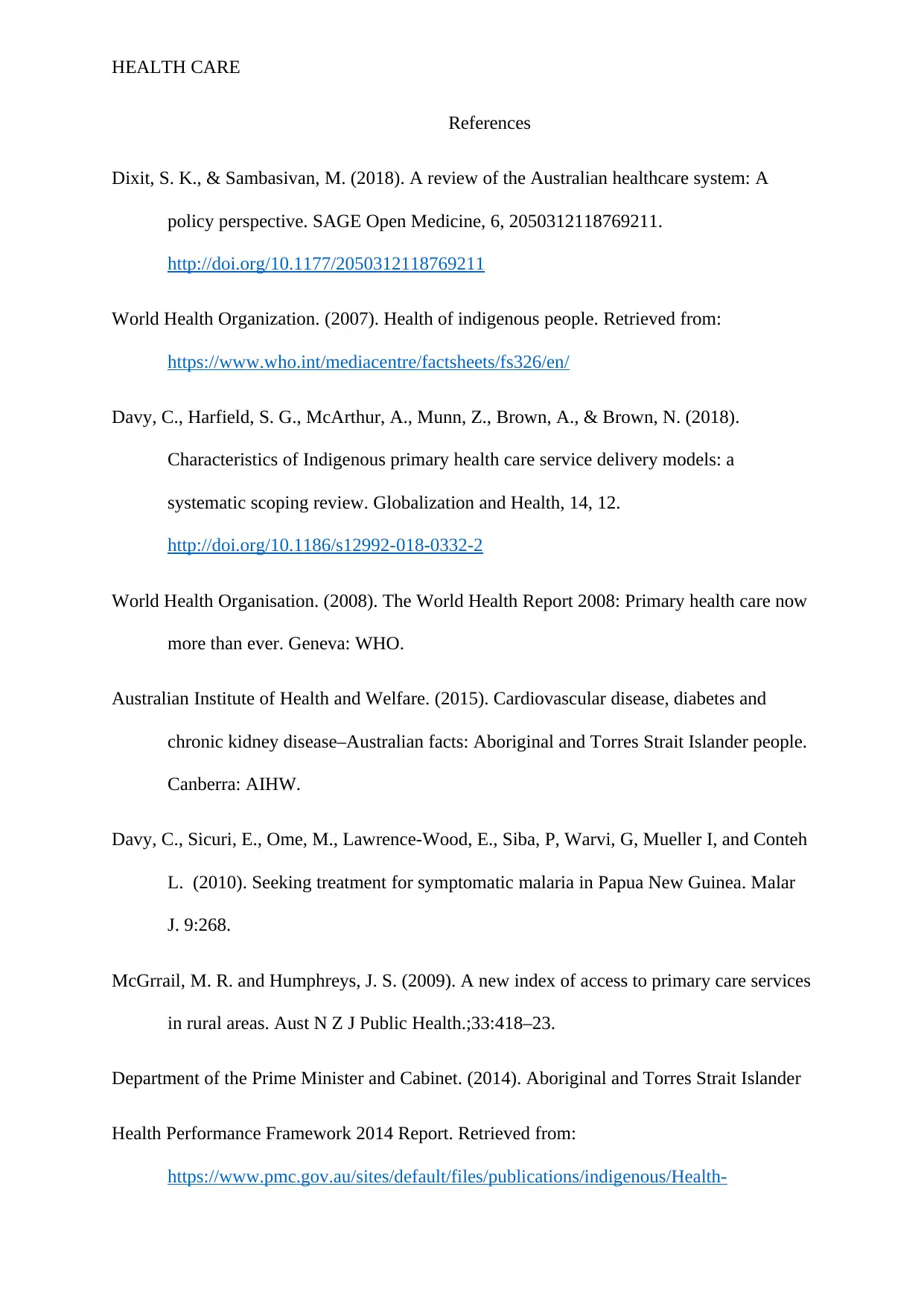
HEALTH CARE
References
Dixit, S. K., & Sambasivan, M. (2018). A review of the Australian healthcare system: A
policy perspective. SAGE Open Medicine, 6, 2050312118769211.
http://doi.org/10.1177/2050312118769211
World Health Organization. (2007). Health of indigenous people. Retrieved from:
https://www.who.int/mediacentre/factsheets/fs326/en/
Davy, C., Harfield, S. G., McArthur, A., Munn, Z., Brown, A., & Brown, N. (2018).
Characteristics of Indigenous primary health care service delivery models: a
systematic scoping review. Globalization and Health, 14, 12.
http://doi.org/10.1186/s12992-018-0332-2
World Health Organisation. (2008). The World Health Report 2008: Primary health care now
more than ever. Geneva: WHO.
Australian Institute of Health and Welfare. (2015). Cardiovascular disease, diabetes and
chronic kidney disease–Australian facts: Aboriginal and Torres Strait Islander people.
Canberra: AIHW.
Davy, C., Sicuri, E., Ome, M., Lawrence-Wood, E., Siba, P, Warvi, G, Mueller I, and Conteh
L. (2010). Seeking treatment for symptomatic malaria in Papua New Guinea. Malar
J. 9:268.
McGrrail, M. R. and Humphreys, J. S. (2009). A new index of access to primary care services
in rural areas. Aust N Z J Public Health.;33:418–23.
Department of the Prime Minister and Cabinet. (2014). Aboriginal and Torres Strait Islander
Health Performance Framework 2014 Report. Retrieved from:
https://www.pmc.gov.au/sites/default/files/publications/indigenous/Health-
References
Dixit, S. K., & Sambasivan, M. (2018). A review of the Australian healthcare system: A
policy perspective. SAGE Open Medicine, 6, 2050312118769211.
http://doi.org/10.1177/2050312118769211
World Health Organization. (2007). Health of indigenous people. Retrieved from:
https://www.who.int/mediacentre/factsheets/fs326/en/
Davy, C., Harfield, S. G., McArthur, A., Munn, Z., Brown, A., & Brown, N. (2018).
Characteristics of Indigenous primary health care service delivery models: a
systematic scoping review. Globalization and Health, 14, 12.
http://doi.org/10.1186/s12992-018-0332-2
World Health Organisation. (2008). The World Health Report 2008: Primary health care now
more than ever. Geneva: WHO.
Australian Institute of Health and Welfare. (2015). Cardiovascular disease, diabetes and
chronic kidney disease–Australian facts: Aboriginal and Torres Strait Islander people.
Canberra: AIHW.
Davy, C., Sicuri, E., Ome, M., Lawrence-Wood, E., Siba, P, Warvi, G, Mueller I, and Conteh
L. (2010). Seeking treatment for symptomatic malaria in Papua New Guinea. Malar
J. 9:268.
McGrrail, M. R. and Humphreys, J. S. (2009). A new index of access to primary care services
in rural areas. Aust N Z J Public Health.;33:418–23.
Department of the Prime Minister and Cabinet. (2014). Aboriginal and Torres Strait Islander
Health Performance Framework 2014 Report. Retrieved from:
https://www.pmc.gov.au/sites/default/files/publications/indigenous/Health-
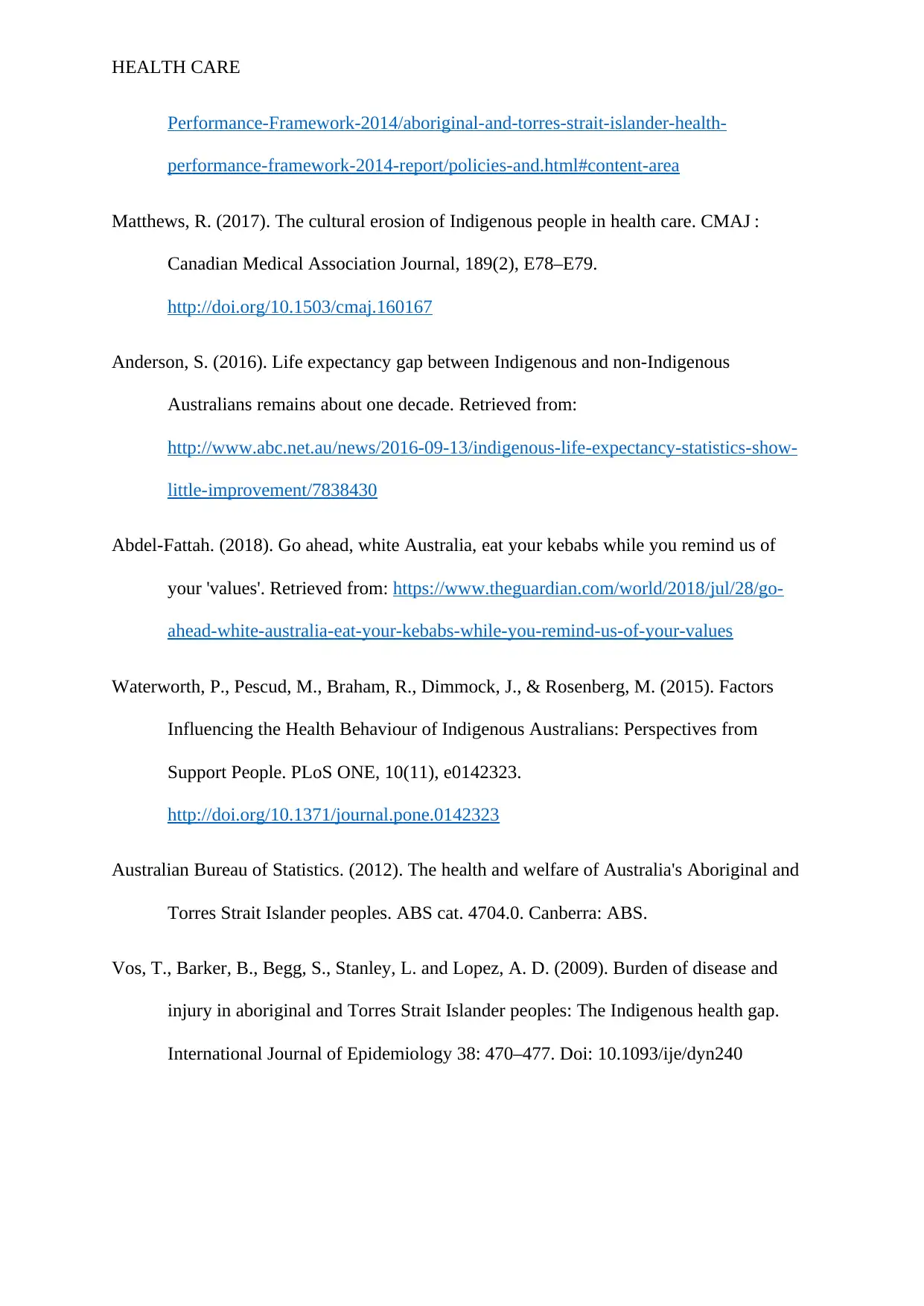
HEALTH CARE
Performance-Framework-2014/aboriginal-and-torres-strait-islander-health-
performance-framework-2014-report/policies-and.html#content-area
Matthews, R. (2017). The cultural erosion of Indigenous people in health care. CMAJ :
Canadian Medical Association Journal, 189(2), E78–E79.
http://doi.org/10.1503/cmaj.160167
Anderson, S. (2016). Life expectancy gap between Indigenous and non-Indigenous
Australians remains about one decade. Retrieved from:
http://www.abc.net.au/news/2016-09-13/indigenous-life-expectancy-statistics-show-
little-improvement/7838430
Abdel-Fattah. (2018). Go ahead, white Australia, eat your kebabs while you remind us of
your 'values'. Retrieved from: https://www.theguardian.com/world/2018/jul/28/go-
ahead-white-australia-eat-your-kebabs-while-you-remind-us-of-your-values
Waterworth, P., Pescud, M., Braham, R., Dimmock, J., & Rosenberg, M. (2015). Factors
Influencing the Health Behaviour of Indigenous Australians: Perspectives from
Support People. PLoS ONE, 10(11), e0142323.
http://doi.org/10.1371/journal.pone.0142323
Australian Bureau of Statistics. (2012). The health and welfare of Australia's Aboriginal and
Torres Strait Islander peoples. ABS cat. 4704.0. Canberra: ABS.
Vos, T., Barker, B., Begg, S., Stanley, L. and Lopez, A. D. (2009). Burden of disease and
injury in aboriginal and Torres Strait Islander peoples: The Indigenous health gap.
International Journal of Epidemiology 38: 470–477. Doi: 10.1093/ije/dyn240
Performance-Framework-2014/aboriginal-and-torres-strait-islander-health-
performance-framework-2014-report/policies-and.html#content-area
Matthews, R. (2017). The cultural erosion of Indigenous people in health care. CMAJ :
Canadian Medical Association Journal, 189(2), E78–E79.
http://doi.org/10.1503/cmaj.160167
Anderson, S. (2016). Life expectancy gap between Indigenous and non-Indigenous
Australians remains about one decade. Retrieved from:
http://www.abc.net.au/news/2016-09-13/indigenous-life-expectancy-statistics-show-
little-improvement/7838430
Abdel-Fattah. (2018). Go ahead, white Australia, eat your kebabs while you remind us of
your 'values'. Retrieved from: https://www.theguardian.com/world/2018/jul/28/go-
ahead-white-australia-eat-your-kebabs-while-you-remind-us-of-your-values
Waterworth, P., Pescud, M., Braham, R., Dimmock, J., & Rosenberg, M. (2015). Factors
Influencing the Health Behaviour of Indigenous Australians: Perspectives from
Support People. PLoS ONE, 10(11), e0142323.
http://doi.org/10.1371/journal.pone.0142323
Australian Bureau of Statistics. (2012). The health and welfare of Australia's Aboriginal and
Torres Strait Islander peoples. ABS cat. 4704.0. Canberra: ABS.
Vos, T., Barker, B., Begg, S., Stanley, L. and Lopez, A. D. (2009). Burden of disease and
injury in aboriginal and Torres Strait Islander peoples: The Indigenous health gap.
International Journal of Epidemiology 38: 470–477. Doi: 10.1093/ije/dyn240
⊘ This is a preview!⊘
Do you want full access?
Subscribe today to unlock all pages.

Trusted by 1+ million students worldwide
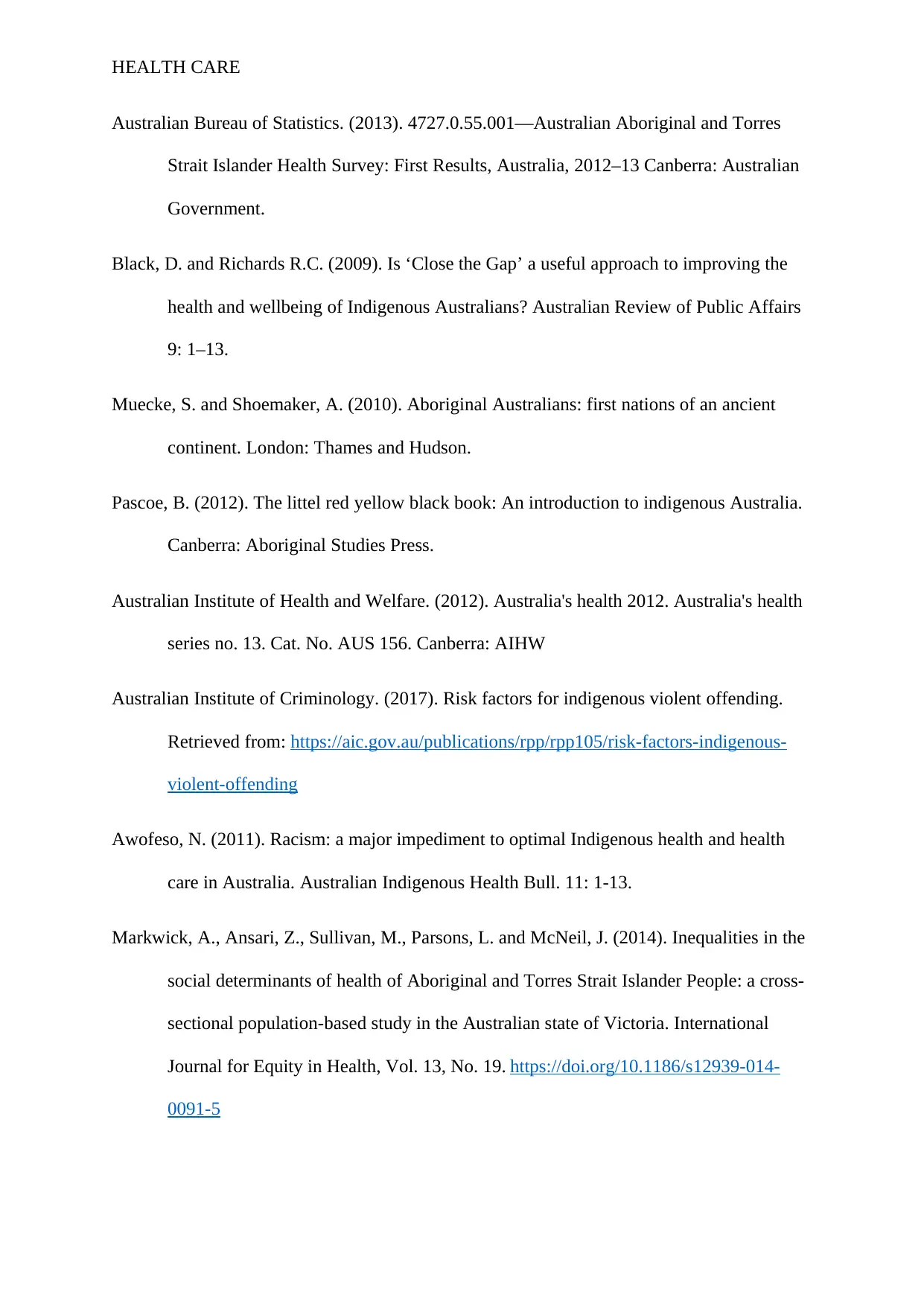
HEALTH CARE
Australian Bureau of Statistics. (2013). 4727.0.55.001—Australian Aboriginal and Torres
Strait Islander Health Survey: First Results, Australia, 2012–13 Canberra: Australian
Government.
Black, D. and Richards R.C. (2009). Is ‘Close the Gap’ a useful approach to improving the
health and wellbeing of Indigenous Australians? Australian Review of Public Affairs
9: 1–13.
Muecke, S. and Shoemaker, A. (2010). Aboriginal Australians: first nations of an ancient
continent. London: Thames and Hudson.
Pascoe, B. (2012). The littel red yellow black book: An introduction to indigenous Australia.
Canberra: Aboriginal Studies Press.
Australian Institute of Health and Welfare. (2012). Australia's health 2012. Australia's health
series no. 13. Cat. No. AUS 156. Canberra: AIHW
Australian Institute of Criminology. (2017). Risk factors for indigenous violent offending.
Retrieved from: https://aic.gov.au/publications/rpp/rpp105/risk-factors-indigenous-
violent-offending
Awofeso, N. (2011). Racism: a major impediment to optimal Indigenous health and health
care in Australia. Australian Indigenous Health Bull. 11: 1-13.
Markwick, A., Ansari, Z., Sullivan, M., Parsons, L. and McNeil, J. (2014). Inequalities in the
social determinants of health of Aboriginal and Torres Strait Islander People: a cross-
sectional population-based study in the Australian state of Victoria. International
Journal for Equity in Health, Vol. 13, No. 19. https://doi.org/10.1186/s12939-014-
0091-5
Australian Bureau of Statistics. (2013). 4727.0.55.001—Australian Aboriginal and Torres
Strait Islander Health Survey: First Results, Australia, 2012–13 Canberra: Australian
Government.
Black, D. and Richards R.C. (2009). Is ‘Close the Gap’ a useful approach to improving the
health and wellbeing of Indigenous Australians? Australian Review of Public Affairs
9: 1–13.
Muecke, S. and Shoemaker, A. (2010). Aboriginal Australians: first nations of an ancient
continent. London: Thames and Hudson.
Pascoe, B. (2012). The littel red yellow black book: An introduction to indigenous Australia.
Canberra: Aboriginal Studies Press.
Australian Institute of Health and Welfare. (2012). Australia's health 2012. Australia's health
series no. 13. Cat. No. AUS 156. Canberra: AIHW
Australian Institute of Criminology. (2017). Risk factors for indigenous violent offending.
Retrieved from: https://aic.gov.au/publications/rpp/rpp105/risk-factors-indigenous-
violent-offending
Awofeso, N. (2011). Racism: a major impediment to optimal Indigenous health and health
care in Australia. Australian Indigenous Health Bull. 11: 1-13.
Markwick, A., Ansari, Z., Sullivan, M., Parsons, L. and McNeil, J. (2014). Inequalities in the
social determinants of health of Aboriginal and Torres Strait Islander People: a cross-
sectional population-based study in the Australian state of Victoria. International
Journal for Equity in Health, Vol. 13, No. 19. https://doi.org/10.1186/s12939-014-
0091-5
Paraphrase This Document
Need a fresh take? Get an instant paraphrase of this document with our AI Paraphraser
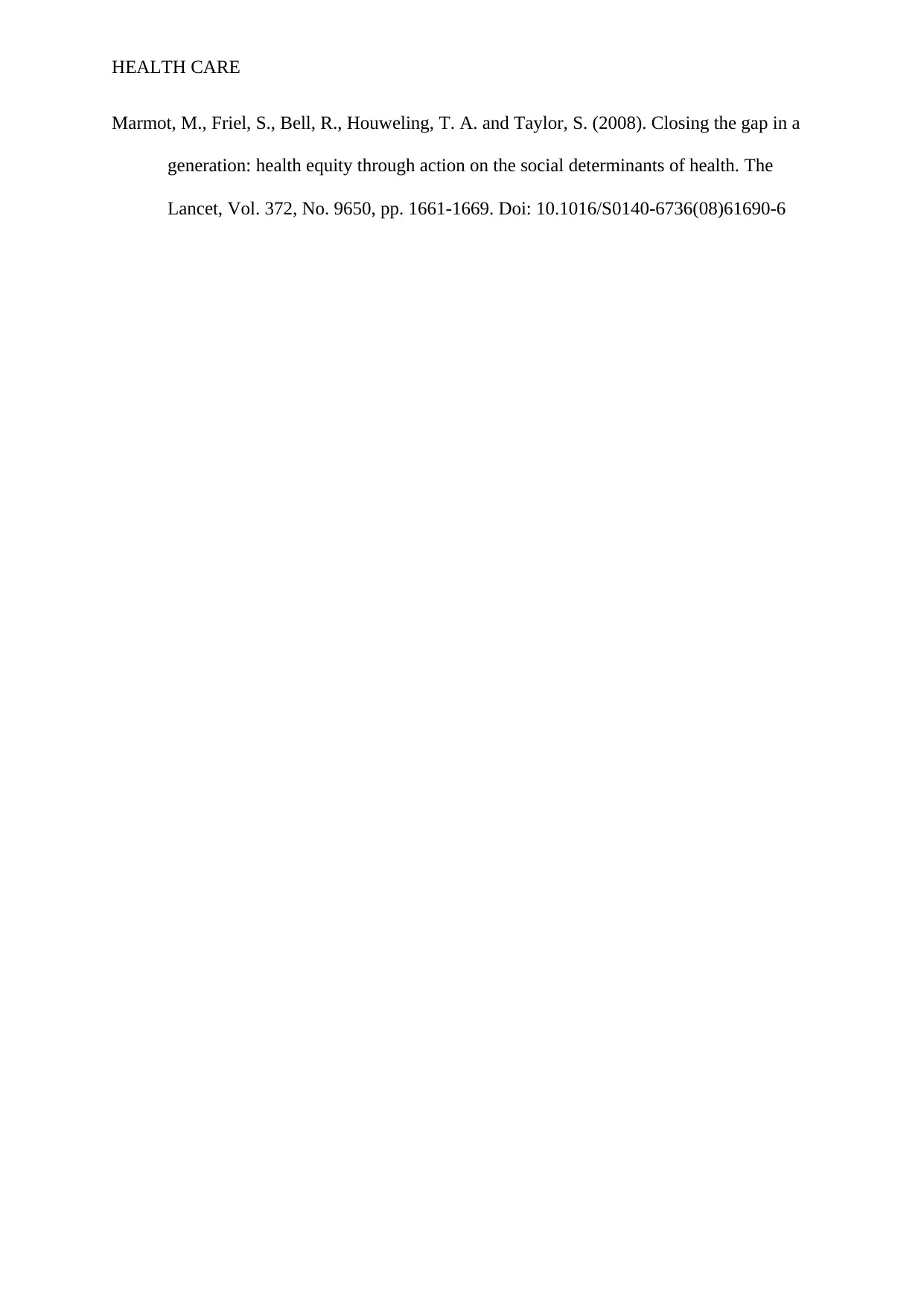
HEALTH CARE
Marmot, M., Friel, S., Bell, R., Houweling, T. A. and Taylor, S. (2008). Closing the gap in a
generation: health equity through action on the social determinants of health. The
Lancet, Vol. 372, No. 9650, pp. 1661-1669. Doi: 10.1016/S0140-6736(08)61690-6
Marmot, M., Friel, S., Bell, R., Houweling, T. A. and Taylor, S. (2008). Closing the gap in a
generation: health equity through action on the social determinants of health. The
Lancet, Vol. 372, No. 9650, pp. 1661-1669. Doi: 10.1016/S0140-6736(08)61690-6
1 out of 11
Related Documents
Your All-in-One AI-Powered Toolkit for Academic Success.
+13062052269
info@desklib.com
Available 24*7 on WhatsApp / Email
![[object Object]](/_next/static/media/star-bottom.7253800d.svg)
Unlock your academic potential
Copyright © 2020–2025 A2Z Services. All Rights Reserved. Developed and managed by ZUCOL.





